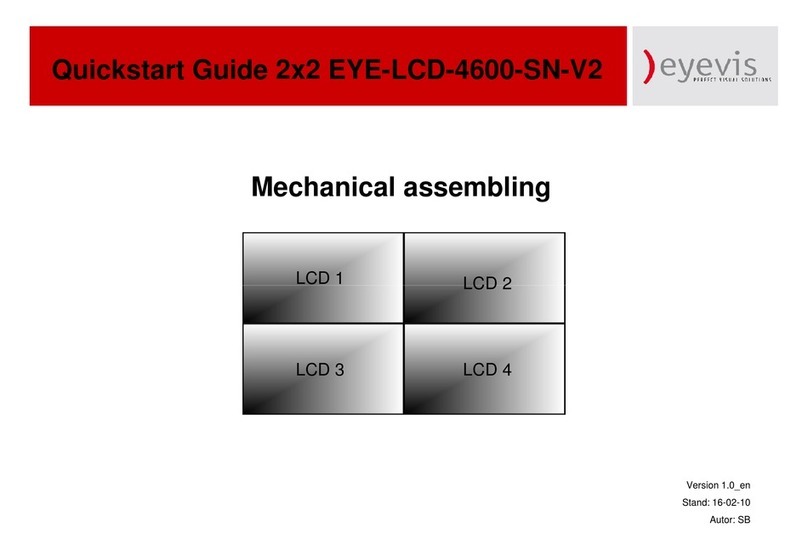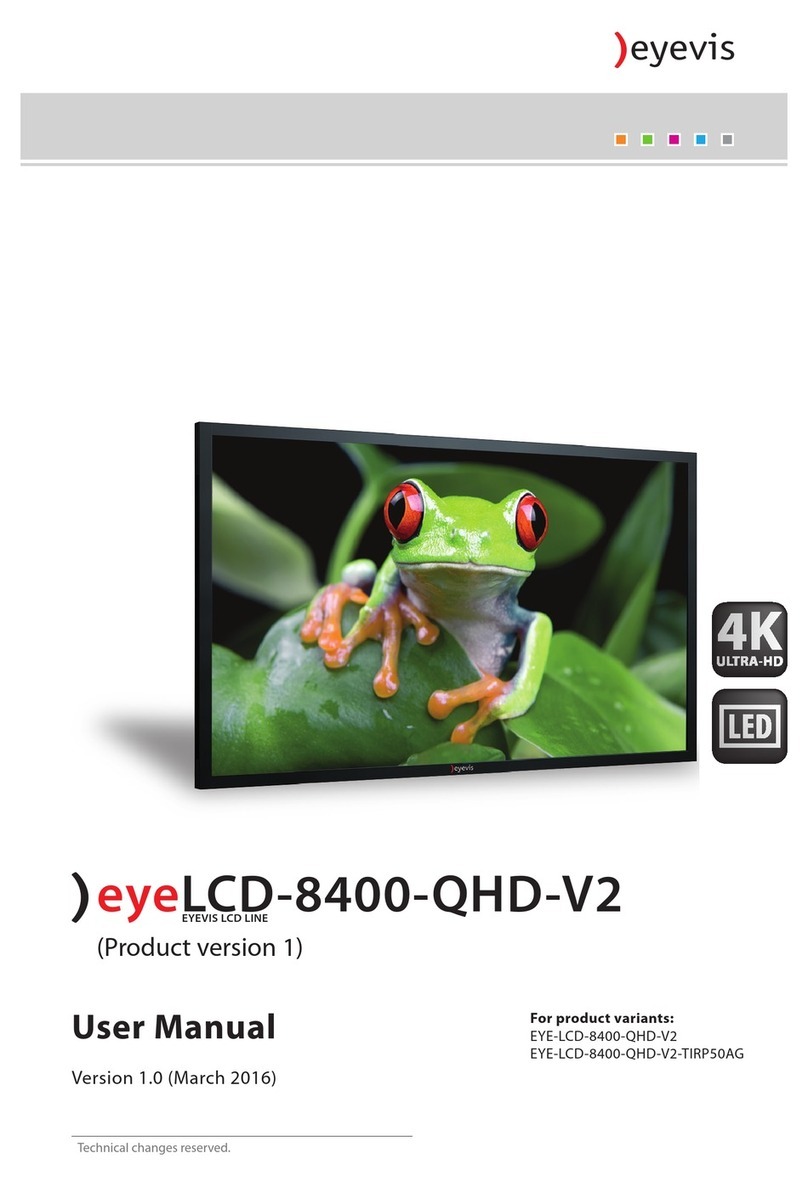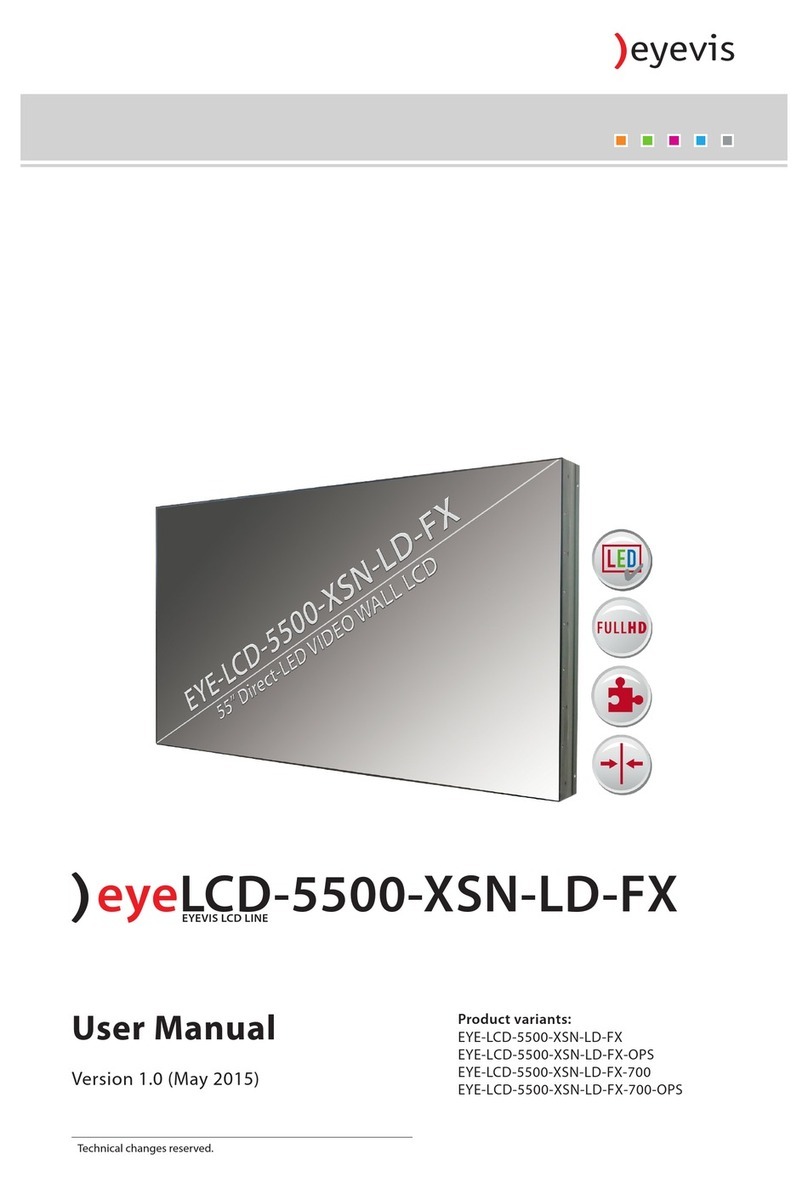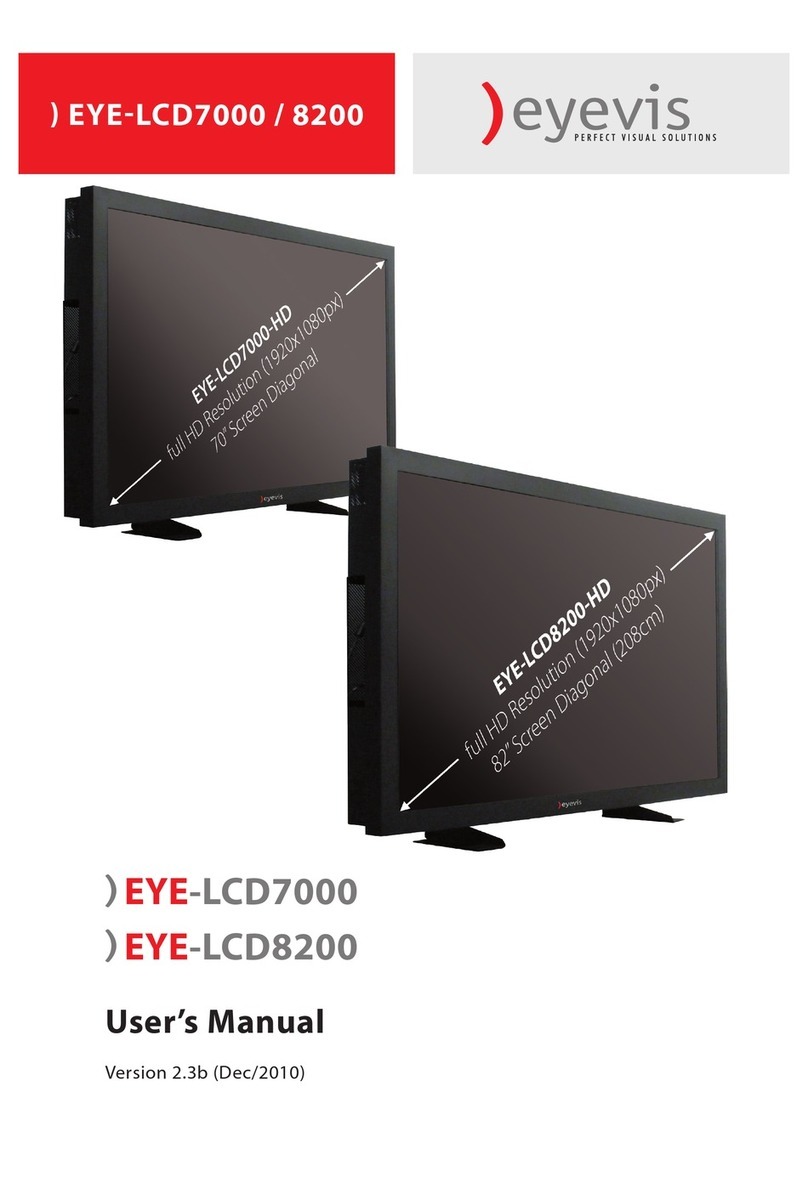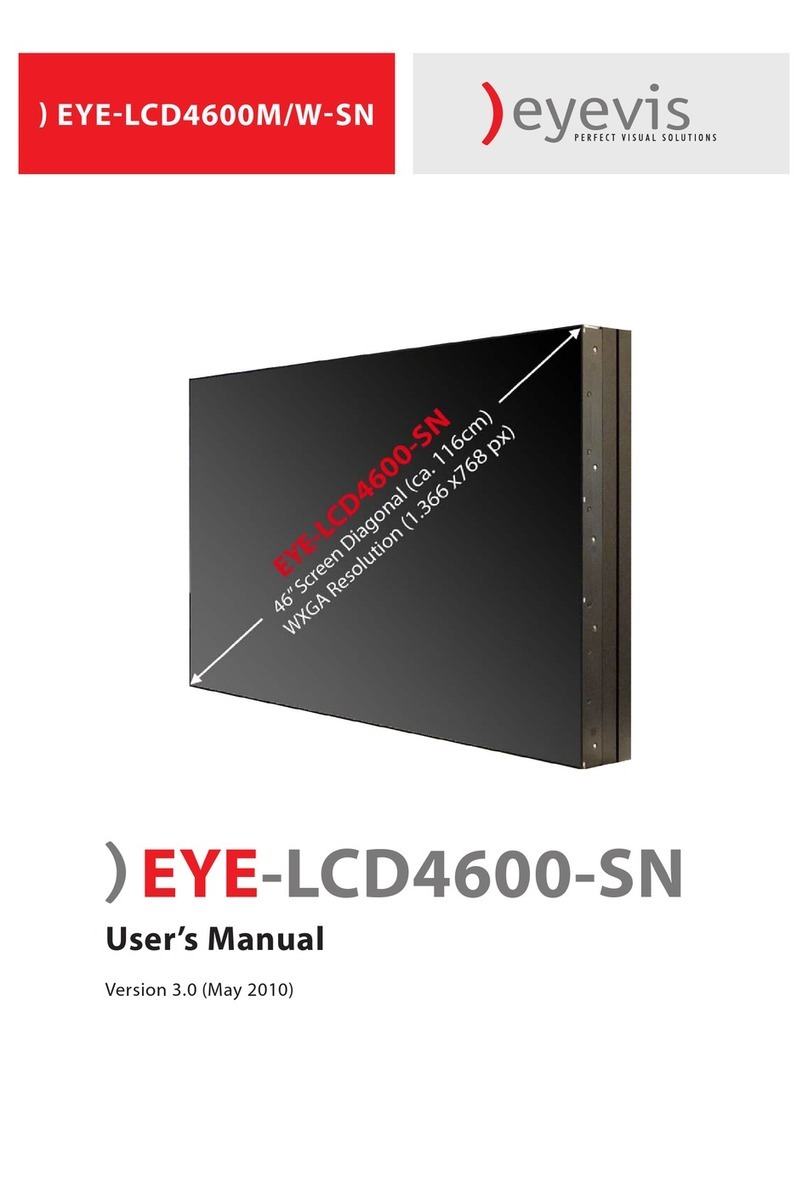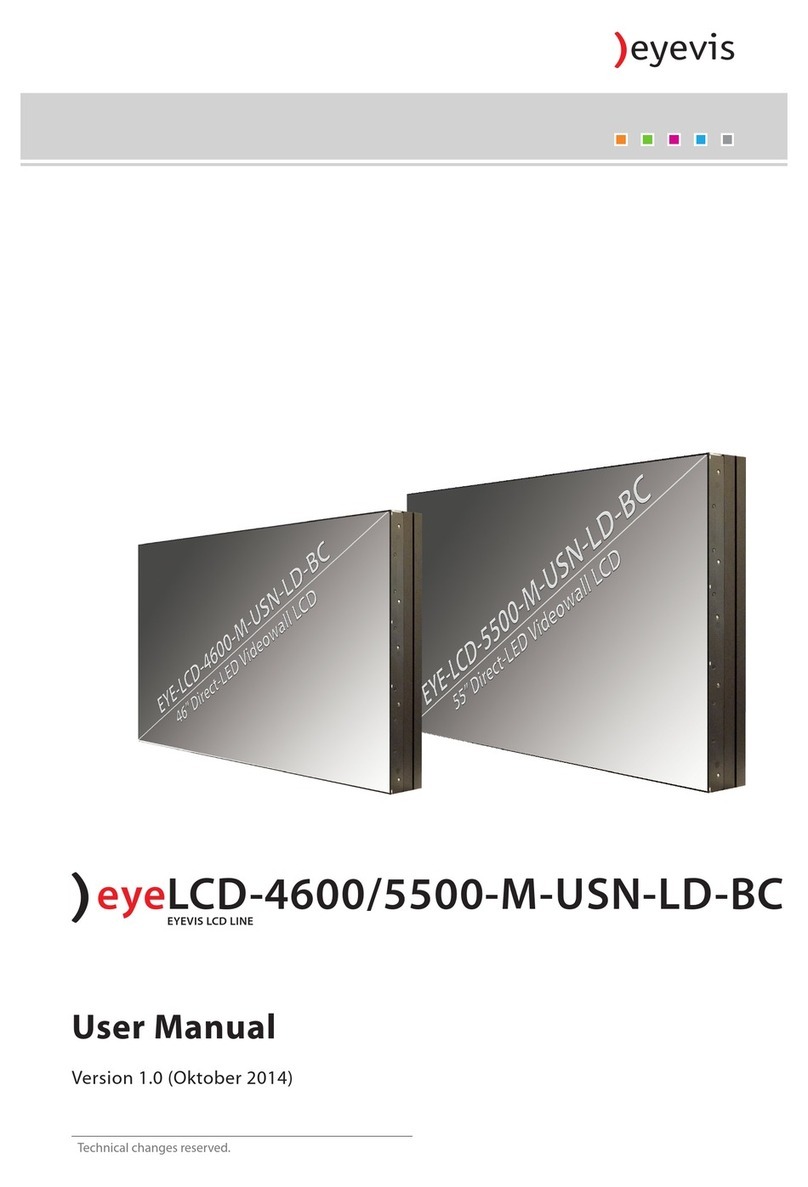Table of Content
Safety / Sicherheit / Sécurité 6
Safety precaution . . . . . . . . . . . . . . . . . . . . . . . . . . . . . . . . . .6
Sicherheitsvorkehrungen . . . . . . . . . . . . . . . . . . . . . . . . . 12
Précautions de sécurité . . . . . . . . . . . . . . . . . . . . . . . . . . . 18
About our Product 23
Features. . . . . . . . . . . . . . . . . . . . . . . . . . . . . . . . . . . . . . . . . 23
High-Resolution wide-screen panel � � � � � � � � � � � � � � � � � � � 23
Connection possibilities� � � � � � � � � � � � � � � � � � � � � � � � � � � � � � 23
Advantages of the EYE-LCD-8500-QHD-LD . . . . . . . . . . 23
Packaging . . . . . . . . . . . . . . . . . . . . . . . . . . . . . . . . . . . . . . . 24
Unpacking � � � � � � � � � � � � � � � � � � � � � � � � � � � � � � � � � � � � � � � � � � 24
Packing list � � � � � � � � � � � � � � � � � � � � � � � � � � � � � � � � � � � � � � � � � 24
Accessory box � � � � � � � � � � � � � � � � � � � � � � � � � � � � � � � � � � � � � � � 25
Connectors and Connections 26
Main power switch and AC inlet. . . . . . . . . . . . . . . . . . . . 26
Power switches � � � � � � � � � � � � � � � � � � � � � � � � � � � � � � � � � � � � � � 26
Input and output connections . . . . . . . . . . . . . . . . . . . . . 27
Operating the Display 28
Setup process. . . . . . . . . . . . . . . . . . . . . . . . . . . . . . . . . . . . 28
Turning display on and off . . . . . . . . . . . . . . . . . . . . . . . . 29
Turning the display on � � � � � � � � � � � � � � � � � � � � � � � � � � � � � � � 29
Turning the display off � � � � � � � � � � � � � � � � � � � � � � � � � � � � � � � 29
Adjusting volume and input source . . . . . . . . . . . . . . . . 29
Adjusting the volume � � � � � � � � � � � � � � � � � � � � � � � � � � � � � � � � 29
Selecting the input source� � � � � � � � � � � � � � � � � � � � � � � � � � � � 29
OSD Keypad, IR-Sensor, LED . . . . . . . . . . . . . . . . . . . . . . . 30
Ambient light sensor� � � � � � � � � � � � � � � � � � � � � � � � � � � � � � � � � 30
IR receiver� � � � � � � � � � � � � � � � � � � � � � � � � � � � � � � � � � � � � � � � � � � 30
LED indicator light� � � � � � � � � � � � � � � � � � � � � � � � � � � � � � � � � � � 30
OSD keypad function list . . . . . . . . . . . . . . . . . . . . . . . . . . 31
Basic functions of OSD keypad and remote control� � � � � 31
Power button functions of OSD keypad and remote control
31
Power button functions of EPU(*) � � � � � � � � � � � � � � � � � � � � � � 31
Avoiding image retention . . . . . . . . . . . . . . . . . . . . . . . . . 32
Rotating the display . . . . . . . . . . . . . . . . . . . . . . . . . . . . . . 32
Installing touch-screen 33
Connecting the touch screen . . . . . . . . . . . . . . . . . . . . . . 33
Connecting cables and switching on � � � � � � � � � � � � � � � � � � 33
Installing the Multi-Touch software . . . . . . . . . . . . . . . . 34
Calibrating the touch screen. . . . . . . . . . . . . . . . . . . . . . . 36
Controlling the display 38
The Remote Control (RC) . . . . . . . . . . . . . . . . . . . . . . . . . . 38
Opening the On-Screen-Display (OSD) � � � � � � � � � � � � � � � � 38
Navigating in the OSD menu � � � � � � � � � � � � � � � � � � � � � � � � � 38
Hot Key - OSD menu lock/unlock� � � � � � � � � � � � � � � � � � � � � � 38
Overview remote control functions . . . . . . . . . . . . . . . . 39
Changing the remote control batteries . . . . . . . . . . . . . 40
Using PIP (Picture-in-Picture) 41
The PIP modes . . . . . . . . . . . . . . . . . . . . . . . . . . . . . . . . . . . 41
Activating and adjusting the PIP modes . . . . . . . . . . . . 41
Window positions of the PIP . . . . . . . . . . . . . . . . . . . . . . . 42
Window sizes of the PIP . . . . . . . . . . . . . . . . . . . . . . . . . . . 42
PIP SWAP function. . . . . . . . . . . . . . . . . . . . . . . . . . . . . . . . 43
PIP Audio . . . . . . . . . . . . . . . . . . . . . . . . . . . . . . . . . . . . . . . 43
Using the On-Screen-Display (OSD) menus 44
Navigating through the menu system . . . . . . . . . . . . . . 44
Opening the On-Screen-Display (OSD) � � � � � � � � � � � � � � � � 44
Navigating in the OSD menu � � � � � � � � � � � � � � � � � � � � � � � � � 44
OSD menu overview . . . . . . . . . . . . . . . . . . . . . . . . . . . . . . 45
Input menu � � � � � � � � � � � � � � � � � � � � � � � � � � � � � � � � � � � � � � � � � 45
Picture menu� � � � � � � � � � � � � � � � � � � � � � � � � � � � � � � � � � � � � � � � 46
Color Temp & Gamma menu� � � � � � � � � � � � � � � � � � � � � � � � � � 47
Audio menu� � � � � � � � � � � � � � � � � � � � � � � � � � � � � � � � � � � � � � � � � 48
OSD menu � � � � � � � � � � � � � � � � � � � � � � � � � � � � � � � � � � � � � � � � � � 49
Setup menu � � � � � � � � � � � � � � � � � � � � � � � � � � � � � � � � � � � � � � � � � 50
Real Time Clock menu � � � � � � � � � � � � � � � � � � � � � � � � � � � � � � � 51
Advanced Settings menu� � � � � � � � � � � � � � � � � � � � � � � � � � � � � 52
Communication menu � � � � � � � � � � � � � � � � � � � � � � � � � � � � � � � 53
IP Address Settings menu � � � � � � � � � � � � � � � � � � � � � � � � � � � � 54
Information menu � � � � � � � � � � � � � � � � � � � � � � � � � � � � � � � � � � � 55
Troubleshooting guide 56
Malfunction or trouble. . . . . . . . . . . . . . . . . . . . . . . . . . . . 56
Effects in continuous operation of LCDs 57
Image sticking � � � � � � � � � � � � � � � � � � � � � � � � � � � � � � � � � � � � � � 57
Mura � � � � � � � � � � � � � � � � � � � � � � � � � � � � � � � � � � � � � � � � � � � � � � � 57
Shade formation � � � � � � � � � � � � � � � � � � � � � � � � � � � � � � � � � � � � 57
EYE-LCD-8500-QHD-LD 3
Version 1.3 | June 2015
